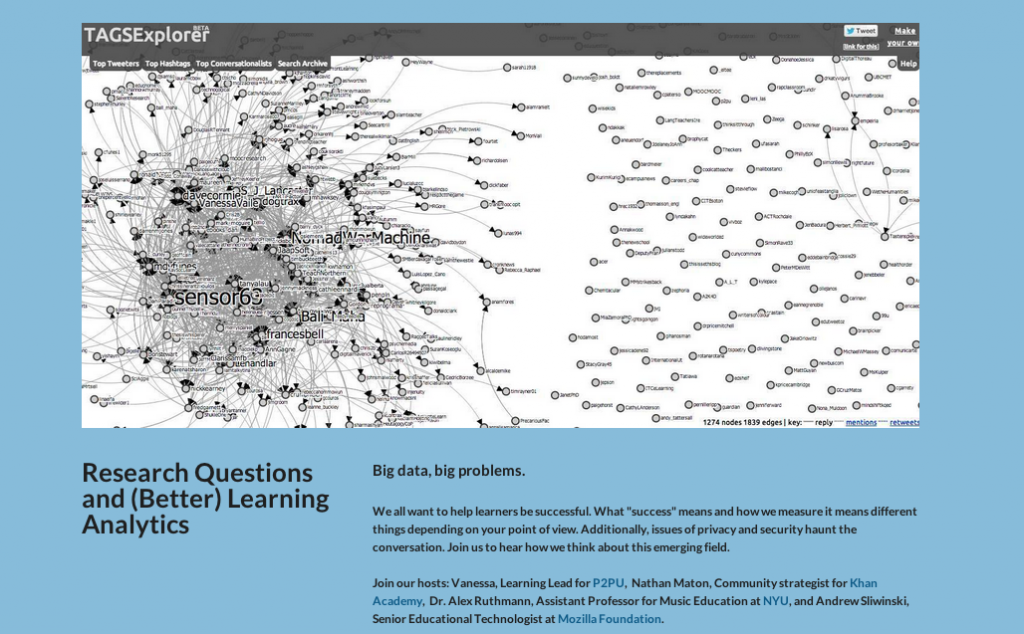Today we approached the second installment on questions of scale in our series “The Big Questions” with Nathan Maton, Community Strategist at the Khan Academy, Terry Heick, Director at TeachThought, Andrew Sliwinski, Senior Educational Technologist at Mozilla Foundation, and Alex Ruthmann, Associate Professor at NYU.
Take a look as we tackle:
– Context setting: is there a binary between online & offline?
– How do certain tools bridge the gap between online and offline? Examples: Makey Makey, Noteflight.
– Recommendations for setting consistent spaces
– How offline contexts/spaces encourage learning to become truly cultural
– What does anonymity afford? What are the tradeoffs?
– Does thinking about “offline” separate to online hinder face-to-face experiences?
Our takeaways & lessons learned:
Andrew Sliwinski
- We are now seeing the emergence of physical communities that are “born” from digital worlds. This has the potential to deepen opportunities for collaboration and lead to greater learning outcomes – how do we help facilitate this?
- Can anonymity exist when digital learning becomes physical? (See Vanessa’s point below)
Nathan Maton
- The goal of whether you’re creating long term experiences for a small group of people in the same space or less persistent experiences with more people defines what happens next in designing learning experiences that capture the best from online and offline.
- Only online can you do anonymity well, which creates a huge advantage for it for many learning experiences as anonymity allows more flexibility and experimentation on the learners part (although you have to watch out for trolls).
- Mobile changes everything when it comes to what happens online and what happens offline. We have so little insight into how that works, and how that create social connections even more so. It’s really exciting but tough to imagine how it works outside of the few folks who have smart phones. This is the biggest opportunity to explore how these two environments can work well together. I’d love to hear more stories of people doing this.
- Thinking about social is tougher when we’re thinking about the bridge of two separate spaces. Building community / social experiences is hard enough in one space. Two spaces make it that much tougher.
Alex Ruthmann
- As designers of learning/making communities, the importance of:
– Starting by understanding our participants as humans/persons…
– Understanding the blurred nature of our participants’ locations, spaces and places…
– Providing opportunities for participants to express their personal voice and make choices…
- How can we better connect people to our personal and the collective community’s learning/content pathways?
- Positive affordances of anonymity
- Research/Terms of Use/Internal Data Collection perspectives: (How) do we balance participants’ rights and permissions researching and documenting experiences in blurred online/offline environments. (metaphors other than surveillance?)
- Possible solution – Encourage public documentation such as at http://buildinprogress.herokuapp.com/ as a reflective/synthesizing aspect of learning/experience design. “Research” and documentation as an integral part of the learning environment – making learning visible and tangible to other participants within and across our communities.
- Examples where online anonymity for kids seems to be working:
Vanessa Gennarelli
- The blurring of online/offline can happen in several ways: supportive information, show evidence for project-based learning, find documentation (though I’m most supportive of the project-based learning/evidence scenario)
- Good information for our upcoming School of Internet of Things design.
- I’m personally torn between the affordances of anonymity (liberates us from some gender and socioeconomic issues, privacy, nurture vulnerability) and the real-world applications of project-based learning (building a portfolio, showing the evolution of your learnings)
Links mentioned include:
Join us for the next conversation on July 29th at 12 pm EST on Scale: Research Questions and (Better) Learning Analytics. Grab your spot here.
